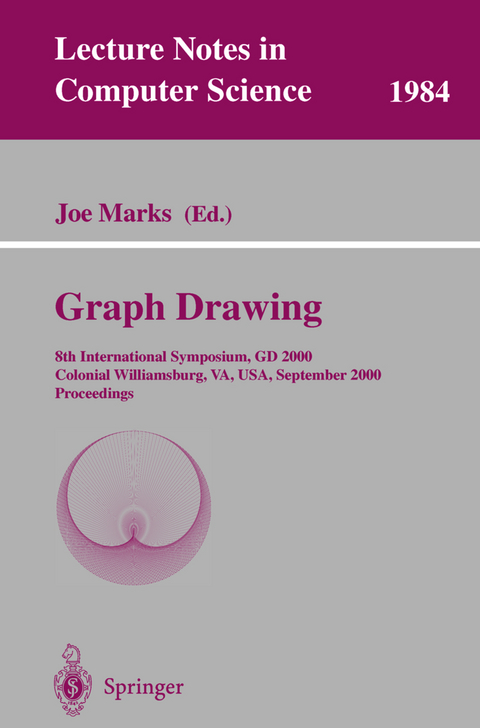
Graph Drawing
Springer Berlin (Verlag)
978-3-540-41554-1 (ISBN)
Invited Talk.- The Visual Representation of Information Structures.- Empirical Studies and Standards.- User Preference of Graph Layout Aesthetics: A UML Study.- A User Study in Similarity Measures for Graph Drawing.- Interactive Partitioning System Demonstration, Short.- An Experimental Comparison of Orthogonal Compaction Algorithms.- GraphXML - An XML-Based Graph Description Format.- Theory I.- On Polar Visibility Representations of Graphs.- A Linear Time Implementation of SPQR-Trees.- Labeling Points with Rectangles of Various Shapes.- How to Draw the Minimum Cuts of a Planar Graph.- Applications and Systems.- 2D-Structure Drawings of Similar Molecules.- Fast Layout Methods for Timetable Graphs.- An Algorithmic Framework for Visualizing Statecharts.- Visualization of the Autonomous Systems Interconnections with Hermes.- Drawing Hypergraphs in the Subset Standard (Short Demo Paper).- Invited Talk.- Knowledge Discovery from Graphs.- Force-Directed Layout.- A Multilevel Algorithm for Force-Directed Graph Drawing.- A Fast Multi-scale Method for Drawing Large Graphs.- FADE: Graph Drawing, Clustering, and Visual Abstraction.- A Multi-dimensional Approach to Force-Directed Layouts of Large Graphs.- GRIP: Graph dRawing with Intelligent Placement.- k-Level Graph Layout.- A Fast Layout Algorithm for k-Level Graphs.- Graph Layout for Displaying Data Structures.- k-Layer Straightline Crossing Minimization by Speeding Up Sifting.- Orthogonal Drawing I.- Lower Bounds for the Number of Bends in Three-Dimensional Orthogonal Graph Drawings.- Orthogonal Drawings of Cycles in 3D Space.- Three-Dimensional Orthogonal Graph Drawing with Optimal Volume.- Orthogonal Drawing II.- A Linear-Time Algorithm for Bend-Optimal Orthogonal Drawings of Biconnected Cubic Plane Graphs.- Refinement ofThree-Dimensional Orthogonal Graph Drawings.- Theory II.- ?-Searchlight Obedient Graph Drawings.- Unavoidable Configurations in Complete Topological Graphs.- Minimum Weight Drawings of Maximal Triangulations.- A Layout Algorithm for Bar-Visibility Graphs on the Möbius Band.- Symmetry and Incremental Layout.- An Algorithm for Finding Three Dimensional Symmetry in Trees.- On Maximum Symmetric Subgraphs.- Clan-Based Incremental Drawing.- The Marey Graph Animation Tool Demo.- Workshop and Contest.- Graph Data Format Workshop Report.- Graph-Drawing Contest Report.
| Erscheint lt. Verlag | 10.1.2001 |
|---|---|
| Reihe/Serie | Lecture Notes in Computer Science |
| Zusatzinfo | XII, 422 p. |
| Verlagsort | Berlin |
| Sprache | englisch |
| Maße | 155 x 233 mm |
| Gewicht | 608 g |
| Themenwelt | Informatik ► Theorie / Studium ► Algorithmen |
| Mathematik / Informatik ► Mathematik ► Wahrscheinlichkeit / Kombinatorik | |
| Schlagworte | aes • Algorithm analysis and problem complexity • Algorithmic Graphy Theory • algorithms • combinatorics • data structures • Diagram Design • Graph • Graph Computations • Graph Drawing • Graph Editing • Graph Layout • Graph Representation • graph theory • Hypergraph • Information Visualization • Partition • SiM • unified modeling language (UML) • Visualization |
| ISBN-10 | 3-540-41554-8 / 3540415548 |
| ISBN-13 | 978-3-540-41554-1 / 9783540415541 |
| Zustand | Neuware |
| Haben Sie eine Frage zum Produkt? |
aus dem Bereich


